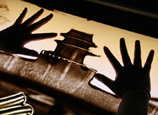
Some say it was the Door gods that saved Li Fangfu and his studio in Mianzhu, Sichuan Province, from complete destruction in the 2008 Wen-chuan earthquake. Last representative inheritor of the venerable Mianzhu woodblock printing craft, Li Fangfu, now 83, and his workers have honored for decades this everyday deity through the woodblock prints they produce in Li's studio.
Chen Xingcai, Li Fangfu's fellow state-level inheritor of Mianzhu woodblock prints, having passed away last year, Li is the last exponent of the craft and sole bearer of this title.
Li was born in 1930 in Gongxing, a small town in Mianzhu County. At age 12 he was apprenticed to Master Huang Anfu of the northern school of woodblock printed art. Decades of dedication have made Li skilled in the sophisticated four-color printing techniques of the school and nurtured his distinctive style. Streams of domestic and international buyers specializing in this Chinese folk art come every year to see Li in his 10-square-meter studio on a nondescript alley and place orders for his works.
Li received official recognition of his lifetime achievements and contributions to Chinese New Year prints in 2006, when he was included among China's first batch of Inheritors of Intangible Cultural Heritage.
Woodblock Prints as Intangible Cultural Heritage
Mianzhu woodblock prints became popular in the Song Dynasty (960-1279), when China's printing industry thrived. They represent one of the four major schools of traditional Chinese New Year prints, the other three being those of Yangliuqing in Tianjin, Yangjiabu in Weifang, Shandong Province, and Taohuawu of Suzhou in Jiangsu Province. All four were included in the first batch of National Intangible Cultural Heritage.
In earlier times, papermaking was the main industry in Mianzhu. Workshops that lined the small river running through the town produced fine paper of high repute in the area. They laid foundations for Mianzhu's flourishing woodblock printing trade.
Similar to the Western custom of hanging wreaths of holly on the front door at Christmastide, the Chinese tradition of decorating homes with New Year prints at Spring Festival, or Lunar New Year, goes back centuries. Ladies of the house decorate doors, windows, halls, inner chambers, the kitchen stove, and even water jars with colorful and auspicious New Year prints to herald the advent of spring.
The demand for Chinese New Year Prints has waxed and waned, revived and mutated, but they have long been acknowledged as quintessential Chinese folk art.
Along with Sichuan opera and cuisine, Mianzhu woodblock prints, with their accumulation of characteristically Sichuan-style folk New Year paintings, are instantly identifiable as a main aspect of the Bashu culture. Each starts with a sketch that is then drawn, outlined, printed and painted. It is the coloring process that distinguishes Mianzhu woodblock prints, because each piece of work is individually hand-painted. It is hence fair to say that every Mianzhu woodblock print is unique.
 |
















 Migrant children’s dream of stage
Migrant children’s dream of stage


![]()
